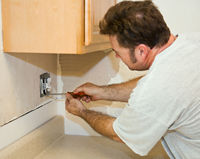
The kitchen is regarded as a “certifiable” area when it comes to electrics. This means that all work carried out must be done by a qualified person who will test the work once completed. For this reason, the information given here is for information only and to help in the design of your electrical system. You can of course leave your electric sockets exactly where they currently are which will mean you won’t need the work tested. However, if you are installing an electric cooker it will need to be installed by an electrician.
Position for Power Outlets
Work out exactly where you need sockets and for how many appliances. Draw this onto a plan to give to your electrician. Consider the following:
- Fridge/freezer
- Washing machine
- Tumble dryer
- Dishwasher
- Toaster
- Kettle
- Coffee machine
- Radio or television (consider placement of an aerial socket as well)
Add a few extra sockets for anything new you might buy.
Your cooker will need to be on a different circuit to your other sockets and should be hard-wired into the wall. It will also have a circuit breaker switch on the wall so you don’t have to unplug it to turn it off.
You can save on the costs of the electrician by doing some of the work yourself. Cutting out the holes for the switch boxes and all the making good of the walls can be good ways of cutting backs on costs.
Your electrician should come back to install the front plates of the switches when you are ready at the end of your project.
Kitchen Lighting
If you are putting in a brand new kitchen, chances are you will want to install a new lighting system as well. Think about this in advance and show your designs to your electrician before any cabinetry goes in.
Ceiling lights may include down lighters, spotlights and directional lights for highlighting areas where you need extra coverage.
Low level lighting includes those which are under cupboards. These can be run along your lighting circuit or plugged into the wall in the usual way. Either way, your electrician will be able to install these.
Led lighting is also popular in kitchens now with floor lighting around plinths and also around pelmets.
